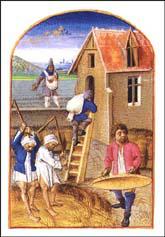Arms and Armour
BASINET: A helmet that protected the sides of the face and neck. The basinet usually had a visor, a metal plate attached to the helmet skull that could be pulled down to protect the face.
BATTLE-AXE: A battle-axe was used in hand-to-hand fighting or could be hurled as a missile. The wooden handle could be as long as 150 cm (5 feet). The crescent-shaped blade measured about 25 cm (10 inches) between the upper and lower points of its broad cutting edge. Made of steel, the battle-axe was capable of cutting off a limb or a head in one blow. During combat the axe was usually wielded with both hands and so the warrior was not able to carry a shield to protect himself against the enemy.
BOW: The bow was used by both sides at the Battle of Hastings. It was the weapon used by soldiers of low rank. In the Bayeux Tapestry only one archer is wearing a hauberk and a helmet. The bow used by the Normans were only pulled back to the chest and had a killing range of about 90 metres (100 yards). The bow was about 50 centimetres (20 inches) long and was made of yew or ash wood.
CANNON: A large gun that used gunpowder to fire stone or iron balls. Cannons were first employed in battle in Europe in the 1330s. The early cannons were unreliable and had a tendency to explode and kill the gunners.
CHAUSSES: Stockings made of mail.
COIF: A hood, usually of mail, worn under a helmet to protect the neck in battle.
CROSSBOW: A crossbow is a small, horizontal bow. Crossbows made of wood were used by the Normans at the Battle of Hastings. The bolt was laid in a groove along the top of the the wooden tiller. The bolt was aimed by holding the end of the tiller to the cheek. The bolt was released by pressing a trigger at the rear of the tiller.
HAUBERK: Knee-length mail shirt that weighed about 14 kg (31 Ibs). Hauberks were put on over the head, and were split at the front and the back to enable the knight to ride his horse.
KETTLE HAT: A round-shaped helmet with a broad brim. This type of helmet was useful in seigework because the brim helped to deflect missiles from the face.
KITE SHIELD: A long, triangular shield with a rounded top used by the Normans. Made of wood, iron and leather, shields were used to parry blows. The size of the shield enabled it to be used to protect the legs as well as the body. Sometimes the shield was employed to knock an enemy knight off his horse.
LANCE: A horseman's spear about 2m (6 feet 6 inches) long. A lance was usually made of ash wood with a small iron or steel head. Sometimes spears were hurled through the air like javelins. On other occasions they were carried under
the arm and used to stab enemy soldiers. Important knights would have flags ("gonfanons") on their lances. By the 13th century lances were rarely less than 3m (10 feet) long.
LONGBOW: The longbow became an important weapon in the 14th century. It was much longer than the traditional bow. The longbow varied in length from 1.82m (6 feet) to 1.93m (6 feet 6 inches). The bow string was made of flax or linen and coated with beeswax. A skilled longbowman could kill an enemy soldier over 365m (400 yards) away. Mail armour provided no protection against the steel-tipped, 'bodkin' arrowheads. The longbow was a difficult weapon to use. The secret of success was practise. Most successful archers learnt how to use the weapon in childhood.
MACE: A short club-like weapon made of wood or steel. Blows from a mace could kill or break the bones of a knight wearing mail armour.
MAIL: Inter-linked and riveted rings of metal. Each link passes through four others and the garment is shaped by the addition and subtraction of rings in appropriate places.
PLATE ARMOUR: First used in about 1260. Plate armour was initially used to protect elbows and knees. Later knights began wearing breastplates, arm guards and greaves (to protect the legs). Plate armour was made from iron or steel. By the 1400s knights were entirely encased in suits of armour weighing about 27 kg (60 Ibs).
POT HELM: Flat-topped helmet popular in the 13th century. This helmet had a reinforced rim at the top where the heavy blows were likely to fall.
SPANGENHELM: Helmets used by the Normans in the 11th century. These cone-shaped helmets were made of bronze and iron. A nasal guard was riveted onto the bottom rim of the helmet. Written accounts suggest that these helmets were an effective defence against swords and axes.
SPURS: Y-shaped metal objects strapped to the heel. Spurs were used to drive the horse forward. Spurs and stirrups helped the knight to control his horse. Stirrups were made of leather and enabled the knight to keep his legs straight during battle. This held him securely in place while delivering or receiving blows.
SWORDS: A knight's sword was his most prized weapon. The sword was often named and was handed down from generation to generation. Norman swords normally had a broad, double-edged blade, and were about 76 cm (2 feet 6 inches) long. A good sword made of steel was unlikely to break during a battle. The handle was usually made of wood but the cross guard was made of iron.

